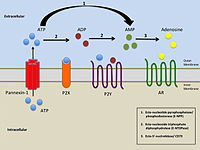
Photo from wikipedia
Finding new biomarkers and molecular targets to guide OA treatment remains a significant challenge. One of the most frequent forms of RNA methylation, N6-methyladenosine (m6A), can affect gene expression and… Click to show full abstract
Finding new biomarkers and molecular targets to guide OA treatment remains a significant challenge. One of the most frequent forms of RNA methylation, N6-methyladenosine (m6A), can affect gene expression and RNA transcription, processing, translation, and metabolism. Osteoarthritis (OA) can cause disability and pain degenerative disease, reduce the quality of life of the elderly, and increase the social and economic burden. Changes in m6A levels are crucial in OA progress. In this review, the discussion will concentrate on the role that m6A plays in OA occurrence and progression. The m6A involved in the OA process mainly includes METTL3 and FTO. Current studies on m6A and OA primarily focus on four signaling pathways, namely, NF-κB, LNCRNAs, ATG7, and Bcl2. m6A participates in these signaling pathways and affects cellular inflammation, apoptosis, senescence, and autophagy, thus controlling the OA process. The modification of m6A affects so many signaling pathways. For the treatment of OA, it may represent a viable new therapeutic target.
Journal Title: Frontiers in Molecular Neuroscience
Year Published: 2022
Link to full text (if available)
Share on Social Media: Sign Up to like & get
recommendations!